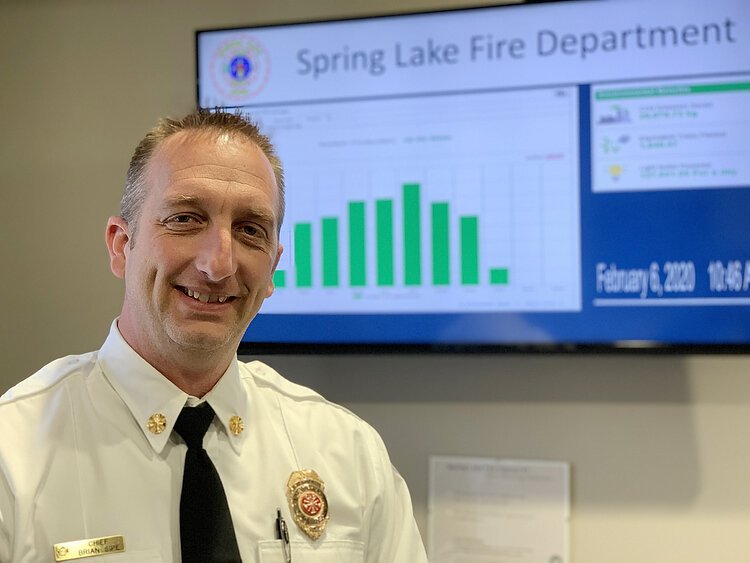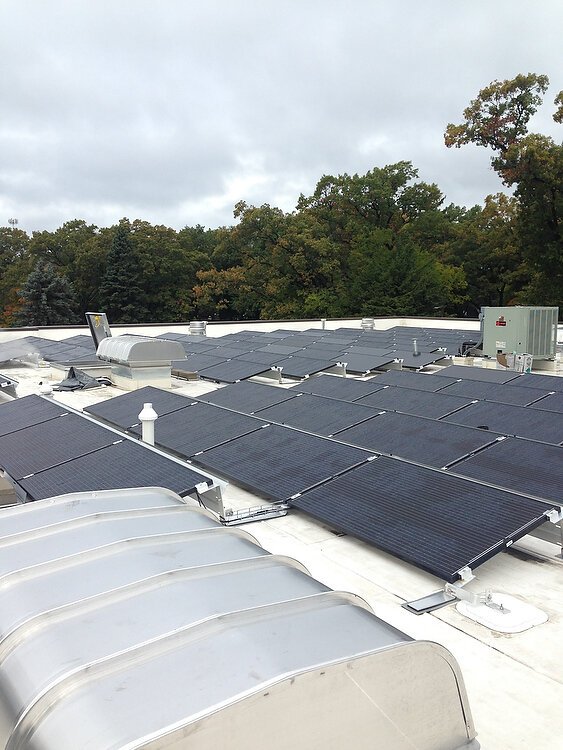How a Spring Lake fire station is inspiring communities to use solar power
The station's success with solar energy has inspired similar projects across North Ottawa County. Muskegon solar provider Chart House Energy has made the decision easy for area municipalities by giving them the option of paying no upfront costs.

When you think of fire stations, you usually think red, the color of most fire trucks. The Spring Lake Fire Department station, however, is all about going green.
Their biggest step forward, when it comes to sustainability, is using the sun to power the facility, at 106 N. Fruitport Road. There are nearly 150 solar panels that lay in a grid of black rectangles across the station’s roof. Inside the lobby, a monitor hangs on the wall that flashes graphs and charts showing the energy savings.
In a state known for its gray and cloudy winter skies, the solar panels still provide energy year-round. Peak time is March through October but, even in January and February, the solar array is collecting UV rays, explains Fire Chief Brian Sipe.

$3,000 annual savings
He estimates the station saves more than $3,000 a year in energy costs.
“If you want the community to go down a path of sustainability, you need to lead by example. We want to be leaders in sustainability,” says Sipe, who has been chief seven of his 20 years with the department.
The township’s success with solar power has inspired similar projects among its North Ottawa County neighbors. Ferrysburg installed solar panels on its City Hall in 2019. So did nearby Norton Shores in Muskegon County on a fire station in 2018. This year, the Village of Spring Lake plans to add solar panels to the Village Hall and its Department of Public Works building.
Sparking this trend is Spring Lake Township Supervisor John Nash, a retired high school science teacher who added a solar collector to the roof of his home decades ago. In the last few years, he has upgraded to solar panels. He has also added a solar-powered water heater and attic fan.
‘Walk your talk’
Several years ago when the township was planning to build a fire station, Nash saw the potential to construct a building that met LEED requirements (Leadership in Energy and Environmental Design) a green building certification program used worldwide.
“I told the board if it wasn’t at least Sliver LEED, I would retire,” Nash says. “I believe you need to walk your talk.”
Thanks to points generated by incorporating solar panels, not only did the station garner a gold LEED certification, it was named the 2018 “Building of the Year” for the municipal and commercial buildings across Michigan. The station was the second LEED fire station in the state. The other is in Traverse City.
The 2016 project was a significant factor in the township’s selection as a 2018 Township of Excellence by the Michigan Township Association, its second such designation in the last decade.
“There was some resistance at first, but everybody was very, very happy we went in this direction. It’s doing very well, paying for itself,” Nash says.
Chart House Energy has made the decision to add solar panels an almost no-brainer for area municipalities by giving them the option of no upfront costs.
Significant drop in cost
The Muskegon-based solar developer recoups its costs by monetizing the tax credits allocated to the project — they can’t be accessed by tax-exempt government entities, so they can be purchased by others. The rules of federal tax credits require the company to own the equipment for five years.
“We try to work with government agencies and nonprofits so they can have access to solar,” explains Chart House Energy’s Emily Prehoda, noting that the company doesn’t normally extend the same financial terms to residential and commercial customers.

As the company’s policy and innovation director, she helps design and coordinate solar installations for commercial and industrial consumers, as well as helps to develop solar projects that create a positive community impact.
The cost of solar energy has been dropping significantly over the past decade as capacity has grown, says Prehoda, who has a doctorate in Environmental and Energy Policy from Michigan Technological University.
She spoke about the company’s work and the industry on Jan. 28, during the Sustainable Lakeshore Forum, at Grand Valley State University’s Robert B. Annis Water Resources Institute in Muskegon.
There is much room for growth in solar in Michigan, but it lags behind other states when it comes to providing support policies and programs, according to Prehoda. Michigan recently passed the solar property tax exemption, making it the only state incentive for solar. But residents and consumers can still qualify for federal tax incentives.
“Michigan ranks pretty poorly because of a lack of policies and programs that support solar energy,” Prehoda says.
Growing industry
More solar projects could mean more jobs in a growing industry. Positions cover a wide spectrum, including installation, operations, maintenance, distribution, electrical, and manufacturing.
The demand for solar industry workers was projected to grow by 13% in 2019. Chart House Energy is utilizing solar to hire and train workers in low-income communities across Michigan as part of an effort to diversify the industry’s workforce.
At the other end of Ottawa County, Chart House Energy has installed solar systems for Holland Board of Public Works customers such as Big Dutchmen, Fog Filler, and Agritek.
Currently, there are about 20 customers, nearly evenly split between businesses and residences, who are generating their own electricity from renewable sources. Most of them are doing that with solar panels, according to Julie DeCook, Holland BPW spokeswoman.
“We have a distributed generation program that allows us to provide a connection to our grid for customers who wish to invest in solar panels for their own personal use. That is advantageous because they continue to have power during times when it is cloudy and when it is dark outside,” she says.
When their solar panels produce more energy than they can use, BPW buys the surplus energy at cost, DeCook adds.
No reason to delay
Ferrysburg City Manager Craig Bessinger opted to move forward with adding solar panels to City Hall after watching the success of the Spring Lake fire station.
“We have battery backup and are able to store power for cloudy days,” Bessinger says. “From October to November, 200 kilowatt-hours were sold back to the Grand Haven Board of Light & Power. In January, there wasn’t anything to sell back,” he says.
Ferrysburg installed the solar panels in 2019 when the City Hall roof was replaced.
What is different about the upcoming Spring Lake Village projects is that the buildings aren’t new or getting new roofs. Village Manager Christine Burns says it doesn’t make sense to delay adding solar panels.
“There are no out-of-pocket expenses for us. I’m hoping I can convince the library board to take a look as well,” says Burns, who was recently appointed to the Spring Lake District Library Board.
She doesn’t think it will be a hard sell.
“We have a lot of people in Spring Lake who are focused on sustainability. This goes hand in hand with the values of our village population.”
This article is part of The Lakeshore, a new featured section of Rapid Growth focused on West Michigan’s Lakeshore region. Over the coming months, Rapid Growth will be expanding to cover the complex challenges in this community by focusing on the organizations, projects, programs and individuals working to improve conditions and solve problems for their region. As the coverage continues, look for The Lakeshore publication, coming in 2020.









